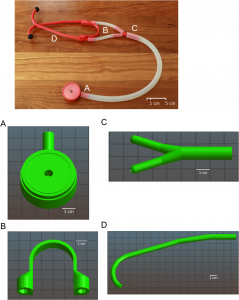Heart, Lungs and Blood Flow. The stethoscope can do it all, no wonder why it is the most widely used piece of medical equipment.
I don’t know about variation around the globe but here in the UK stethoscopes are expensive. The cheaper end of the quality spectrum is around £50, and I go through one every couple of years. I don’t know if that is a reflection on myself or on the quality of the product. The cost and accessibility means they are prohibitive to physiotherapists and medical professionals in low economic areas. I don’t think you’re going to go down to the local market or shop and find a stethoscope.
Considering the cost and difficulty getting one, for something so integral to healthcare settings, shouldn’t something be done to make them cheaper and easier to get?
Well, thanks to a team at the University of Western Ontario in the US a good quality stethoscope could become available for just $2.83.
Low cost isn’t the same as low quality.
Made out of recycled soda-machine tubing,  cheap plastic for the diaphragm and 3D printed plastic parts, the team has created something which is not only cheap but works well. A validation study entitled: Validation of an effective, low cost, Free/open access 3D-printed stethoscope, was published in PLOSone a couple of weeks ago. Results were excellent and the 3D printed piece was just as accurate as a Littmann Cardiology IV ($190).
cheap plastic for the diaphragm and 3D printed plastic parts, the team has created something which is not only cheap but works well. A validation study entitled: Validation of an effective, low cost, Free/open access 3D-printed stethoscope, was published in PLOSone a couple of weeks ago. Results were excellent and the 3D printed piece was just as accurate as a Littmann Cardiology IV ($190).
In terms of cost of investment the team report that a 3D printer costs around $1000, and obviously the printer can be used for printing other things as well.
The power of a stethoscope shouldn’t be under-estimated, I wonder what the team will design next?